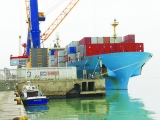Zimbabwe making progress with dry port

Walvis Bay – The Zimbabwean Government has made commendable progress with the construction of the dry port at the harbour town of Walvis Bay expected to be operational within two years.
Namibia granted Zimbabwe the 18 332 square metres piece of land in 2009 to enhance trade between the two countries, but the dry port missed the 2013 completion deadline of the SADC Regional Infrastructure Master Plan (RIDMP).
About 40 percent of the project is complete with earthworks and construction due to be concluded by year end, while the dry port is scheduled to become operational early next year, says Taná Pesat, Namport Manager of Corporate Communication.
SADC Heads of State and Government adopted the RIDMP at their 32nd SADC Ordinary Summit held in August 2012 in Maputo, Mozambique.
The Master Plan is in line with the Programme for Infrastructure Development of Africa (PIDA), which is a continental initiative of the African Union Commission (AUC), in partnership with the United Nations Economic Commission for Africa (UNECA), African Development Bank (AfDB) and the NEPAD Planning and Coordinating Agency (NPCA).
Botswana’s 36 233 square metre dry port at Walvis Bay has been completed and is already operational, while Zambia’s 30 152 square metre dry port facility has been operational for over five years now.
Namibia’s western coast is a natural gateway for regional trade, as it offers most landlocked countries in southern Africa direct trade links with the rest of the world.
Namibia’s commercial port, operated by Namport, in Walvis Bay’s deep water harbour is one of the most efficient natural ports on the western coast, with a significant capacity to store and move cargo.
The port receives more than 3 000 vessels, moves about 5 000 tonnes of cargo and has the potential to accommodate up to 350 000 containers each year.
Namport’s trade route network, road and rail, stretches through Botswana, Zimbabwe, Angola, Zambia, Malawi and other land-locked countries in SADC.
It also operates the port of Lüderitz, which is a vital link to markets in the Northern Cape of South Africa and the rest of Namibia.
Some of the goods trafficked into the SADC region include building materials, vehicles, petroleum products, electrical equipment, frozen fish, ship spares, spare parts, copper, zinc and machinery.
Namport Chief Executive Officer, Bisey Uirab, says the most prolific development in terms of increasing capacity and expanding the port of Walvis Bay footprint is undoubtedly the SADC Gateway development, which is situated further north from the current port area.
“There is a growing demand for the import and export of bulk commodities in SADC and this port area will be ideally suited for this purpose.
The 1 330 hectare development will be the key spoke in the Namibia logistics hub and will be a major port gateway serving the “shopping mall” of SADC countries,” he added.
Ministry of Mines and Energy started the development of the SADC Gateway last year with the construction of a Liquid Bulk Terminal.
The terminal is now 20 percent complete.
It will provide two 60 000 DWT tanker berths, which include dredging the entrance channel and turning basin.
Namport has also initiated the feasibility study for the establishment of a Multipurpose Bulk Terminal accommodating under 10 million tonnes per annum at the SADC Gateway.
According to Uirab, about 50 percent of construction of the new container terminal at the Port of Walvis Bay on 40 hectares of reclaimed land has been completed and the infrastructure will accommodate the larger and longer container vessels as well as efficient ship-to-shore cranes.
The terminal, which will be commissioned in early 2018, will have two berths each 600 metres in length, have a -16.0 CD water depth, will be big enough to accommodate container vessels of 8 000 TEUs, and will be able to handle 750 000 TEUs per annum.
Uirab further stressed the importance for Namibia to remain relevant in the SADC region by ensuring that its port infrastructure is on par, if not better, than the competition as they are competing for the same hinterland business with neighbouring ports for cargo to and from Zambia, Zimbabwe, Botswana and the DRC.
“In this stressful time of a marked downturn in business, our dilemma is to strike a balance between satisfying the expectations of the various stakeholders and ensuring we sustain a healthy balance sheet and cash flows.
“More importantly, we must strive to maintain and improve our port of call status in Southern Africa and continue to provide a strong foundation for the establishment of the Namibia Logistics Hub,” he said.
